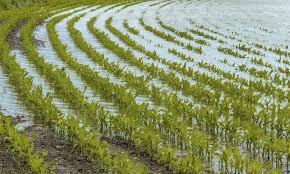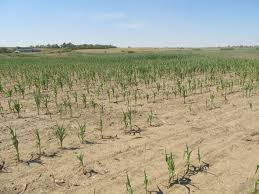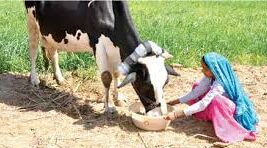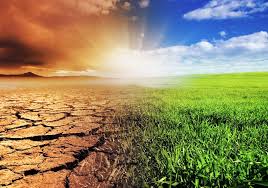Climate change is one of the most significant challenges facing agriculture today, impacting food production, farmer livelihoods, and environmental sustainability. Agriculture relies on stable weather patterns and specific climatic conditions to ensure productive crop yields and healthy livestock.
However, rising temperatures, changing precipitation patterns, and more frequent extreme weather events, such as droughts, floods, and storms, are disrupting agricultural practices worldwide. These changes pose severe risks to food security, threatening the availability, accessibility, and quality of food for billions of people.
One of the primary effects of climate change on agriculture is the alteration of growing seasons and crop yields. Warmer temperatures can speed up plant growth cycles, potentially reducing yields by limiting the time crops have to mature.
Additionally, shifting rainfall patterns lead to water scarcity in some regions while causing flooding in others, both of which can damage crops and soil health. For example, prolonged droughts stress water resources, making irrigation less reliable, while intense rainfall and flooding can wash away essential topsoil, reducing soil fertility.
Livestock farming is also affected, as temperature increases and heatwaves put animals at risk of heat stress, reducing productivity and increasing mortality rates. Furthermore, climate change promotes the spread of pests and diseases that can devastate crops and livestock, increasing the need for pest control measures and veterinary care.
To address these challenges, the agricultural sector is increasingly adopting climate-smart practices, such as conservation agriculture, improved water management, and the use of drought-resistant crop varieties.
These strategies help farmers adapt to changing conditions and improve resilience to climate-related risks. Understanding and addressing the impacts of climate change on agriculture is crucial for securing future food supplies and supporting sustainable development.
Climate change poses significant challenges to global agriculture, affecting crop yields, water resources, and food security:
1. Greenhouse Gas Emissions: Anthropogenic activities, such as burning fossil fuels and deforestation, release greenhouse gases (GHGs) like carbon dioxide (CO2) and methane (CH4) into the atmosphere, contributing to global warming and climate change.
2. Temperature Trends: Over the past century, average global temperatures have risen, leading to shifts in climate patterns, increased frequency of heatwaves, and altered precipitation regimes.
3. Impact on Agroecosystems: Climate change disrupts agroecosystems by affecting crop growth, soil health, pest and disease dynamics, and overall agricultural productivity.
4. Policy and Adaptation: Governments and organizations worldwide are implementing policies and adaptation strategies to mitigate climate impacts on agriculture and promote sustainable farming practices.
Understanding Rising Temperatures
1. Thermal Stress: High temperatures stress crops, livestock, and farm workers, affecting physiological processes, productivity, and health.
2. Heatwave Frequency: Increasing frequency and intensity of heatwaves during critical crop growth stages reduce yields, impair photosynthesis, and increase water demand.
3. Urban Heat Islands: Urbanization amplifies local temperature increases, affecting nearby agricultural areas and exacerbating heat stress on crops and livestock.
4. Heat-Tolerant Crops: Research and breeding programs develop heat-tolerant crop varieties adapted to warmer climates, enhancing resilience and yield stability.
Overview of Extreme Weather Events

Extreme weather events are severe and often unexpected natural phenomena that can have devastating effects on the environment, economies, and communities.
These events include intense storms, prolonged droughts, heatwaves, floods, and hurricanes, among others. In recent years, the frequency and intensity of extreme weather events have increased, largely attributed to climate change, which is disrupting traditional weather patterns and amplifying natural processes.
Types of Extreme Weather Events
1. Droughts: Droughts occur when there is an extended period of below-average precipitation, leading to water shortages. They can severely impact agriculture, causing crop failure, reduced water supply for livestock, and soil degradation. Droughts are particularly challenging for regions that depend heavily on rainfall for food production.
2. Heatwaves: Characterized by prolonged periods of excessively high temperatures, heatwaves can endanger human health, strain energy resources due to increased air conditioning demands, and stress both crops and livestock. Heatwaves can also increase the risk of wildfires, which further damage ecosystems and agricultural lands.
3. Floods: Flooding happens when water overflows onto normally dry land, typically due to heavy rainfall, river overflow, or storm surges. Floods can wash away soil and crops, destroy infrastructure, and displace communities. They also contribute to the spread of waterborne diseases, impacting human health and agriculture.
4. Hurricanes and Typhoons: These powerful tropical storms bring intense winds, heavy rain, and storm surges, leading to coastal flooding, property damage, and loss of life. They can destroy agricultural lands, contaminate water sources, and disrupt food supply chains.
5. Wildfires: Wildfires are often fueled by prolonged heat and dry conditions. These fires can decimate forests, farms, and pastures, leading to loss of biodiversity, soil erosion, and long-term damage to ecosystems.
Extreme weather events have widespread effects on ecosystems, agriculture, infrastructure, and public health. To mitigate these impacts, communities and governments are working on adaptation strategies, such as improved infrastructure, better water management, and early warning systems.
Effects of Temperature Increase on Crop Growth
Temperature increases influence crop physiology, phenology, and yield potential:
1. Phenological Shifts: Warmer temperatures alter crop development stages, including flowering, fruit set, and maturation, impacting yield quality and quantity.
2. Carbon Dioxide Fertilization: Elevated CO2 levels can enhance photosynthesis rates and water use efficiency in some crops, but responses vary by species and environmental conditions.
3. Nutrient Availability: Temperature changes affect soil nutrient availability, plant nutrient uptake, and fertilizer requirements, influencing crop growth and yield outcomes.
4. Climate Smart Agriculture: Adoption of climate-smart agricultural practices, such as precision farming, agroforestry, and soil conservation, enhances resilience to temperature fluctuations and improves resource use efficiency.
Read Also: Sheep gene insights could help farmers breed healthier animals
How Droughts Impact Crop Yields

1. Water Stress: Soil moisture deficits during drought reduce crop water uptake, impair nutrient transport, and limit photosynthesis, leading to yield losses and economic impacts.
2. Crop Water Use Efficiency: Drought-tolerant crop varieties and efficient irrigation technologies optimize water use, improve resilience to water scarcity, and sustain crop yields during dry periods.
3. Economic Losses: Drought-induced crop failures, reduced yields, and increased production costs affect farm incomes, rural livelihoods, and global food prices.
4. Adaptive Strategies: Drought risk management plans, including drought monitoring, early warning systems, and diversified cropping systems, mitigate impacts and enhance agricultural resilience.
The Role of Flooding in Crop Loss
Flooding poses significant risks to agriculture, causing crop damage and yield losses:
1. Soil Erosion: Intense rainfall and runoff during floods erode topsoil, deplete soil nutrients, and reduce soil fertility, impacting crop growth and productivity.
2. Waterlogging: Saturated soils during floods impede root respiration and nutrient uptake, leading to oxygen deprivation and crop stress, particularly in low-lying fields and poorly drained areas.
3. Crop Damage: Submergence of crops in floodwaters damages plant tissues, inhibits photosynthesis, and promotes disease outbreaks, resulting in reduced yields and economic losses for farmers.
4. Recovery Challenges: Post-flood recovery efforts, including soil rehabilitation, crop replanting, and pest management, require significant resources and may prolong agricultural disruptions.
Changes in Pest and Disease Patterns
Climate change influences pest and disease dynamics, affecting crop health and agricultural productivity:
1. Proliferation of Pests: Warmer temperatures and altered precipitation patterns create favorable conditions for pests, accelerating reproduction rates and expanding geographic ranges.
2. Shifts in Disease Distribution: Changing climatic conditions influence disease transmission cycles, vector behaviors, and pathogen survival, increasing crop susceptibility to infections and yield losses.
3. Integrated Pest Management: Adopting integrated pest management (IPM) strategies, such as biological control, resistant crop varieties, and cultural practices, mitigates pest and disease risks sustainably.
4. Surveillance and Early Detection: Monitoring pest populations and disease outbreaks enables timely intervention and preventive measures to minimize crop damage and production losses.
Heat Stress and Its Effects on Livestock
Heat stress compromises livestock health, welfare, and productivity under rising temperatures:
1. Physiological Responses: Heat stress disrupts thermoregulation mechanisms in livestock, leading to increased respiration rates, dehydration, reduced feed intake, and metabolic disorders.
2. Productivity Decline: Reduced milk production, impaired reproductive performance, and compromised growth rates are common consequences of prolonged heat stress in dairy cattle, poultry, and swine.
3. Cooling Strategies: Implementing cooling systems, shade structures, and water misting to mitigate heat stress effects and enhance livestock comfort and productivity during hot weather conditions.
4. Genetic Selection: Breeding heat-tolerant livestock breeds and incorporating heat resilience traits into breeding programs improve animal adaptability and resilience to climate-related heat stress.
Water Availability and Livestock Production
Water scarcity affects livestock hydration, nutrient absorption, and overall production efficiency:
1. Water Requirements: Livestock species vary in water needs, with dairy cattle and poultry requiring ample water for milk production, egg formation, and thermoregulation.
2. Drought Impacts: Limited water availability during droughts reduces grazing lands, forage quality, and water sources, challenging livestock management and nutritional adequacy.
3. Water Quality Concerns: Poor water quality from contamination or salinization compromises livestock health, immunity, and digestive function, necessitating water treatment and management solutions.
4. Resilience Strategies: Enhancing water storage capacity, rainwater harvesting, and efficient water use practices in livestock farming operations mitigate risks of water scarcity and support sustainable production.
Impact of Extreme Weather on Feed Supply
Extreme weather events disrupt feed production, supply chains, and nutritional availability for livestock:
1. Forage Shortages: Droughts, floods, and wildfires impact forage availability, hay yields, and pasture conditions, limiting feed options for grazing livestock and increasing feed costs.
2. Feed Quality Decline: Weather-induced stressors reduce forage quality, nutrient content, and palatability, affecting livestock digestion, metabolic health, and growth performance.
3. Feed Storage Risks: Floods and storms damage feed storage facilities, spoil feed stocks, and compromise feed safety and nutritional integrity, necessitating improved storage practices and contingency plans.
4. Adaptive Feed Strategies: Implementing diversified feed sources, nutritional supplements, and alternative feed crops enhances feed resilience, availability, and nutritional adequacy during climate-related disruptions.
Adaptation Strategies for Crop Farmers
Crop farmers can adopt various strategies to enhance resilience to climate change impacts:
1. Diversified Cropping Systems: Planting a variety of crops with different maturity periods and water needs spreads risks and optimizes resource use in varying climatic conditions.
2. Improved Irrigation Techniques: Investing in efficient irrigation methods, such as drip irrigation and moisture sensors, conserves water, improves soil moisture management, and supports crop growth during dry spells.
3. Climate-Resilient Crop Varieties: Selecting and breeding crop varieties adapted to local climatic conditions, including heat tolerance, pest resistance, and drought resilience, enhances yield stability and farm productivity.
4. Soil Health Management: Practicing soil conservation techniques, such as cover cropping, crop rotation, and organic amendments, enhances soil fertility, structure, and water retention capacity, supporting crop growth and yield potential.
Read Also: 17 Medicinal Health Benefits Of Mucuna pruriens (Monkey Tamarind)
Mitigation Strategies for Livestock Producers

1. Heat Stress Management: Providing shaded areas, water misting systems, and ventilation in livestock facilities mitigates heat stress effects on animal comfort, health, and performance during hot weather.
2. Nutritional Management: Adjusting feed formulations, supplementing with vitamins and minerals, and optimizing nutrient content in livestock diets support resilience to climate-related stressors and maintain production efficiency.
3. Disease Prevention: Implementing biosecurity measures, vaccination programs, and veterinary care protocols reduces disease risks, enhances livestock immunity, and minimizes economic losses associated with climate-driven disease outbreaks.
4. Water Management: Ensuring adequate water supply, quality monitoring, and efficient water use practices support hydration, nutrient absorption, and overall health in livestock, especially during drought conditions.
The Importance of Climate-Resilient Practices
Climate-resilient practices contribute to sustainable agriculture and food security:
1. Enhanced Productivity: Adopting resilient practices increases farm productivity, stabilizes yields, and ensures food supply continuity amidst climate variability and extreme weather events.
2. Resource Efficiency: Efficient resource use, including water, energy, and inputs, reduces production costs, mitigates environmental impacts, and improves farm profitability and sustainability.
3. Ecosystem Conservation: Preserving natural habitats, biodiversity, and ecological services through sustainable farming practices supports ecosystem resilience and enhances agricultural landscapes’ adaptability to climate change.
4. Community Resilience: Building farmer capacity, knowledge sharing networks, and community partnerships fosters resilience to climate impacts, promotes adaptation strategies, and strengthens local food systems.
Policy Responses to Climate Challenges in Agriculture
Governments and policymakers play a crucial role in shaping climate-resilient agriculture:
1. Climate Smart Policies: Implementing policies that incentivize climate-smart practices, research, and innovation, such as carbon pricing, subsidies for sustainable agriculture, and climate adaptation funding.
2. Regulatory Frameworks: Establishing regulations and standards for emissions reductions, land use planning, and natural resource management to mitigate climate impacts and promote sustainable agricultural practices.
3. Financial Support: Providing financial assistance, insurance schemes, and risk management tools to farmers, livestock producers, and rural communities affected by climate-related disasters and market volatility.
4. International Cooperation: Collaborating on global climate agreements, knowledge sharing platforms, and technology transfer initiatives to build resilience, enhance food security, and achieve sustainable development goals.
Future Outlook: Balancing Agriculture and Climate Change
The future of agriculture hinges on proactive adaptation, innovation, and sustainable practices:
1. Technological Advancements: Harnessing digital technologies, precision farming tools, and climate forecasting models improves decision-making, resource allocation, and resilience to climate variability.
2. Research and Development: Investing in agricultural research, breeding climate-resilient crops and livestock, and developing adaptation technologies enhance productivity, sustainability, and food system resilience.
3. Stakeholder Engagement: Engaging farmers, researchers, policymakers, and stakeholders in collaborative initiatives, knowledge exchange, and capacity building strengthens adaptive capacity and promotes holistic climate solutions.
4. Resilient Food Systems: Building resilient food systems, inclusive of smallholder farmers, diversified production systems, and equitable access to resources, ensures food security, economic stability, and environmental sustainability in a changing climate.
Do you have any questions, suggestions, or contributions? If so, please feel free to use the comment box below to share your thoughts. We also encourage you to kindly share this information with others who might benefit from it. Since we can’t reach everyone at once, we truly appreciate your help in spreading the word. Thank you so much for your support and for sharing!
Read Also: 4 Steps to help an Orange Tree Produce Sweet Oranges






